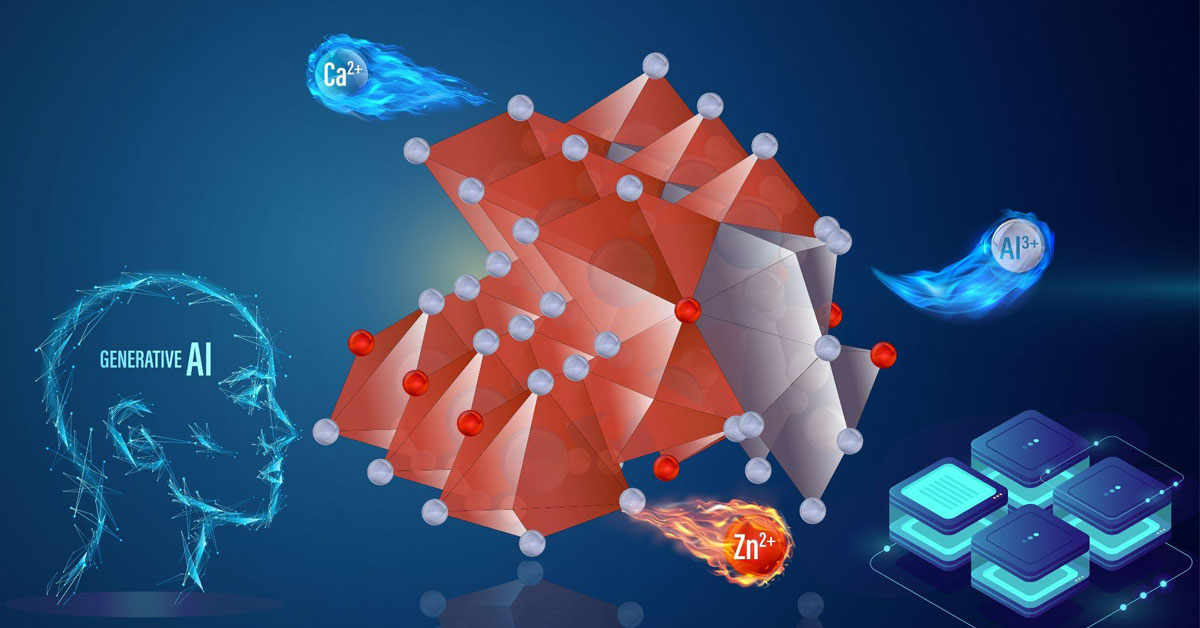News
Discovering the Next Generation of Battery Materials Using Generative AI
Published August 26, 2025
By Kimberly Mann Bruch
As electric vehicles flood global markets and renewable energy storage demands soar, researchers are confronting a harsh reality: the world's battery supply chain depends on lithium, a scarce metal that requires millions of gallons of water to extract and is controlled by just a handful of countries. Now, scientists are turning to some of the most powerful supercomputers in the world to engineer a solution. Using advanced simulations on the Expanse system at the San Diego Supercomputer Center (SDSC), researchers are developing next-generation batteries that could run on abundant metals like magnesium, zinc and aluminum instead—materials so common they could revolutionize how we power everything from smartphones to entire electrical grids.

An overview of generative AI models, such as CDVAE and a fine-tuned LLM trained on an extensive dataset from the MP database, is presented in this approach for constructing crystal structures.
Thanks to U.S. National Science Foundation (NSF) ACCESS allocations on Expanse at SDSC, which is part of the University of California San Diego School of Computing, Information and Data Sciences, simulations helped researchers identify and better understand optimal electrode materials for multivalent-ion batteries: transition metal oxides (TMOs).
“TMOs have a great deal of potential as host materials in multivalent ion batteries,” said Dibakar Datta, associate professor of mechanical engineering at the New Jersey Institute of Technology (NJIT). “They offer structural versatility, high ionic conductivity and an ability to accommodate multiple charge carriers. However, their vast compositional and structural diversity makes traditional exploration inefficient — it’s a classic ‘needle in a haystack’ problem. Thankfully, generative AI-powered by Expanse at SDSC has a knack for helping us pick through haystacks.”
The NJIT team worked closely with colleagues at the Department of Mechanical, Aerospace and Nuclear Engineering at Rensselaer Polytechnic Institute (RPI) and leveraged generative AI to discover optimal TMOs for next-generation batteries. Using SDSC’s Expanse system, the team was able to identify over 40 unique structures that met relevant benchmarks for use as host materials.
To achieve this feat, the researchers used multiple AI models, including crystal diffusion variational autoencoders (CDVAEs), large language models (LLMs) and the atomistic graph neural network (ALIGNN).
“Thanks to the NSF ACCESS allocations, we were able to leverage two powerful generative AI models, CDVAEs and LLMs, on SDSC’s Expanse to effectively address the challenge of discovering novel TMO-based crystal structures,” said RPI Clark and Crossan Chair Nikhil Koratkar, a professor of engineering. “By combining the strengths of CDVAEs and LLMs, we ensured a comprehensive exploration of potential TMO materials.”
Koratkar explained that the CDVAE generated a broad range of plausible crystal structures, while the LLM refined these structures by adding specific, desirable properties. After generating these structures, a forward ML model called the atomistic graph neural network (ALIGNN) was used to predict material properties critical for assessing the thermodynamic and electronic stability of the generated materials, helping to narrow down the selection to the most promising candidates for applications in multivalent-ion batteries.
Initially, the team’s CDVAE and LLM models generated 10,000 structures each. By the end of the process, these results were narrowed down to 42 structures in the CDVAE and 13 in the LLM. Both models offered unique advantages.
“While the LLM was great at generating structures that are already close to thermodynamic equilibrium, which are more directly synthesizable, the CDVAE model explored a broader chemical space, offering great potential for discovering new materials that could be synthesized under non-equilibrium conditions,” Datta said.
The five most stable TMO-based structures shared a common feature — open-tunnel frameworks large enough to accommodate multivalent ions. The researchers verified the structural and thermodynamic stability of these five structures using density functional theory (DFT) calculations, confirming their real-world viability.
“NSF ACCESS is like our oxygen — without it, our research would be completely paralyzed," Datta said. “I am deeply grateful to NSF ACCESS for its incredible support.”
The research was published in Cell Reports Physical Science.
Funding was provided by NSF (award number #2237990). Computational support on Expanse at SDSC was provided by NSF ACCESS (allocation no. DMR180013).

